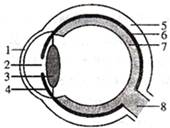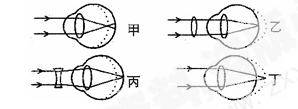据调查,我国的近视眼发病率高居世界第二位,近视逐渐低龄化,发病率呈逐年上升趋势,这引起了人们对学生用眼卫生的高度关注。下图是眼球结构、近视眼成像及矫正原理示意图,请分析回答:

(1)分析上图眼球的结构,在不同光亮程度的环境中,眼球会通过调节[ ]_________的大小,从而调节进入眼球的光量。物体发出的光线,进入眼球时首先穿过的结构是[ ]_________。通过[ ]________的调节作用,物象最终落在[ ]_______上,人才能清晰地看到这个物体。
(2)近视眼是由于眼球过度疲劳,造成某些结构变化不能复原。下图中,能正确表示近视眼戴眼镜前后成像原理的分别是( )、( )。

(3)若人的眼球结构完好无损,但是看不见周围的物体,则发生病变的部位可能是________________________。
(4)汽车司机看见路口红灯立即停车。这一反射过程中能将红灯的刺激转变为神经冲动的是眼球中的[ ]_________。从反射形成的过程看,此反射属于________。
(5)注意眼的清洁卫生,不用脏手擦眼睛,不和他人共用毛巾等,可以避免结膜炎、沙眼等传染病的传染,这在传染病预防措施上属于_______________________。
(1)2瞳孔 1角膜 3晶状体 7视网膜 (2)甲 丙
(3)视神经或视觉中枢 (4)视网膜 条件反射 (5)切断传播途径
题目分析:(1)图示中1角膜,2瞳孔,3晶状体,4虹膜,5巩膜,6脉络膜,7视网膜, ①我们之所以能看远近不同的物体,原因是眼球成像过程中,起主要调节作用的结构是3晶状体,视觉的形成过程是:外界物体反射来的光线,经过角膜、房水,由瞳孔进入眼球内部,再经过晶状体和玻璃体的折射作用,在视网膜上能形成清晰的物像,物像刺激了视网膜上的感光细胞,这些感光细胞产生的神经冲动,沿着视神经传到大脑皮层的视觉中枢,就形成视觉。
(2)长时间的近距离作业,如读书、写字、看电视、玩游戏机等,或光线过暗,使眼睛长时间的调节紧张,头部前倾,眼球内不断的充血,眼内压相应的增高,以及眼外肌的紧张和压迫眼球,使睫状体持续收缩,调节负担过重,导致晶状体过度变凸,不能恢复成原状,或者因调节时牵引涡状静脉,妨碍了血液的流通,使巩膜的抵抗力减弱,严重时使眼球的前后径过长,使远处物体反射来的光线形成的物像,落在视网膜的前方,因此不能看清远处的物体,形成近视,需要配戴凹透镜矫正,图甲是近视眼,佩戴凹透镜后市图丙。
(3)眼球结构完好无损,但是看不见周围的物体,可能是视神经或视觉中枢发生病变。
(4)司机看到红灯刹车是出生后才有的,是在非条件反射的基础上,经过一定的过程,在大脑皮层参与下完成的复杂反射。
(5)注意眼的清洁卫生,不用脏手擦眼睛,不和他人共用毛巾等,可以避免结膜炎、沙眼等传染病的传染,这在传染病预防措施上属于切断传播途径。
